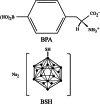Evaluation of sodium borocaptate (BSH) and boronophenylalanine (BPA) as boron delivery agents for neutron capture therapy (NCT) of cancer: an update and a guide for the future clinical evaluation of new boron delivery agents for NCT
- PMID: 38973634
- PMCID: PMC11337926
- DOI: 10.1002/cac2.12582
Evaluation of sodium borocaptate (BSH) and boronophenylalanine (BPA) as boron delivery agents for neutron capture therapy (NCT) of cancer: an update and a guide for the future clinical evaluation of new boron delivery agents for NCT
Abstract
Boron neutron capture therapy (BNCT) is a cancer treatment modality based on the nuclear capture and fission reactions that occur when boron-10, a stable isotope, is irradiated with neutrons of the appropriate energy to produce boron-11 in an unstable form, which undergoes instantaneous nuclear fission to produce high-energy, tumoricidal alpha particles. The primary purpose of this review is to provide an update on the first drug used clinically, sodium borocaptate (BSH), by the Japanese neurosurgeon Hiroshi Hatanaka to treat patients with brain tumors and the second drug, boronophenylalanine (BPA), which first was used clinically by the Japanese dermatologist Yutaka Mishima to treat patients with cutaneous melanomas. Subsequently, BPA has become the primary drug used as a boron delivery agent to treat patients with several types of cancers, specifically brain tumors and recurrent tumors of the head and neck region. The focus of this review will be on the initial studies that were carried out to define the pharmacokinetics and pharmacodynamics of BSH and BPA and their biodistribution in tumor and normal tissues following administration to patients with high-grade gliomas and their subsequent clinical use to treat patients with high-grade gliomas. First, we will summarize the studies that were carried out in Japan with BSH and subsequently at our own institution, The Ohio State University, and those of several other groups. Second, we will describe studies carried out in Japan with BPA and then in the United States that have led to its use as the primary drug that is being used clinically for BNCT. Third, although there have been intense efforts to develop new and better boron delivery agents for BNCT, none of these have yet been evaluated clinically. The present report will provide a guide to the future clinical evaluation of new boron delivery agents prior to their clinical use for BNCT.
Keywords: Boron neutron capture therapy (BNCT); boronophenylalanine (BPA); brain tumors; head and neck cancer; sodium borocaptate (BSH).
© 2024 The Author(s). Cancer Communications published by John Wiley & Sons Australia, Ltd on behalf of Sun Yat‐sen University Cancer Center.
Conflict of interest statement
The authors declare no conflict of interest.
Figures



Similar articles
-
Boron neutron capture therapy of brain tumors: enhanced survival and cure following blood-brain barrier disruption and intracarotid injection of sodium borocaptate and boronophenylalanine.Int J Radiat Oncol Biol Phys. 2000 Apr 1;47(1):209-18. doi: 10.1016/s0360-3016(00)00421-1. Int J Radiat Oncol Biol Phys. 2000. PMID: 10758326
-
Accelerator-based boron neutron capture therapy for malignant glioma: a pilot neutron irradiation study using boron phenylalanine, sodium borocaptate and liposomal borocaptate with a heterotopic U87 glioblastoma model in SCID mice.Int J Radiat Biol. 2020 Jul;96(7):868-878. doi: 10.1080/09553002.2020.1761039. Epub 2020 May 12. Int J Radiat Biol. 2020. PMID: 32339057
-
Boron neutron capture therapy of brain tumors: functional and neuropathologic effects of blood-brain barrier disruption and intracarotid injection of sodium borocaptate and boronophenylalanine.J Neurooncol. 2000 Jul;48(3):179-90. doi: 10.1023/a:1006410611067. J Neurooncol. 2000. PMID: 11100816
-
Boron neutron capture therapy at the crossroads: challenges and opportunities.Appl Radiat Isot. 2009 Jul;67(7-8 Suppl):S3-6. doi: 10.1016/j.apradiso.2009.03.102. Epub 2009 Apr 1. Appl Radiat Isot. 2009. PMID: 19467879 Review.
-
Boron delivery agents for neutron capture therapy of cancer.Cancer Commun (Lond). 2018 Jun 19;38(1):35. doi: 10.1186/s40880-018-0299-7. Cancer Commun (Lond). 2018. PMID: 29914561 Free PMC article. Review.
Cited by
-
157Gd-DOTA-PSMA as theranostic bio-gadolinium agent for prostate cancer targeted gadolinium neutron capture therapy.J Cancer Res Clin Oncol. 2025 Feb 25;151(2):93. doi: 10.1007/s00432-025-06136-7. J Cancer Res Clin Oncol. 2025. PMID: 40000479 Free PMC article.
-
L‑type amino acid transporter 1 in enhancing boron neutron capture therapy: Mechanisms, challenges and future directions (Review).Int J Mol Med. 2025 Nov;56(5):170. doi: 10.3892/ijmm.2025.5611. Epub 2025 Aug 24. Int J Mol Med. 2025. PMID: 40849804 Free PMC article. Review.
-
Unraveling aromaticity: the dual worlds of pyrazole, pyrazoline, and 3D carborane.Beilstein J Org Chem. 2025 Feb 21;21:412-420. doi: 10.3762/bjoc.21.29. eCollection 2025. Beilstein J Org Chem. 2025. PMID: 39996167 Free PMC article.
-
A Novel Closo-Ortho-Carborane-Based Glucosamine Derivative as a Promising Agent for Boron Neutron Capture Therapy.Pharmaceuticals (Basel). 2025 Jun 30;18(7):986. doi: 10.3390/ph18070986. Pharmaceuticals (Basel). 2025. PMID: 40732275 Free PMC article.
-
Boron neutron capture therapy of cancer: where do we stand now?Cancer Commun (Lond). 2024 Aug;44(8):889-892. doi: 10.1002/cac2.12581. Epub 2024 Jul 8. Cancer Commun (Lond). 2024. PMID: 38973667 Free PMC article. No abstract available.
References
-
- Hatanaka H, Amano K, Kamano S, Sano K. Clinical experience of boron‐neutron capture therapy for malignant brain tumors (1968 ‐ 1985). In: Hatanaka H, editor. Boron neutron capture therapy for tumors. Japan: Nishimura Niigata; 1986:447–449.
-
- Hatanaka H, Kamano S, Amano K, Hojo S, Sano K, Egawa S, et al. Clinical experience of boron‐neutron capture therapy for gliomas‐a comparison with conventional chemo‐immuno‐radiotherapy. In: Hatanaka H, editor. Boron neutron capture therapy for tumors. Japan: Nishimura Niigata; 1986:349–378.
-
- Mishima Y, Honda C, Ichihashi M, Obara H, Hiratsuka J, Fukuda H, et al. Treatment of malignant melanoma by single thermal neutron capture therapy with melanoma‐seeking 10B‐compound. Lancet. 1989;2(8659):388–389. - PubMed
-
- Chanana AD, Capala J, Chadha M, Coderre JA, Diaz AZ, Elowitz EH, et al. Boron neutron capture therapy for glioblastoma multiforme: interim results from the phase I/II dose‐escalation studies. Neurosurgery. 1999;44(6):1182–1192; discussion 92‐3. - PubMed
-
- Kato I, Fujita Y, Maruhashi A, Kumada H, Ohmae M, Kirihata M, et al. Effectiveness of boron neutron capture therapy for recurrent head and neck malignancies. Applied Radiation and Isotopes. 2009;67(7, Supplement):S37–S42. - PubMed
Publication types
MeSH terms
Substances
LinkOut - more resources
Full Text Sources

